Interviews
Interview with Jim & Laini Di Bartolo
By
Hervé St-Louis
June 15, 2004 - 14:11
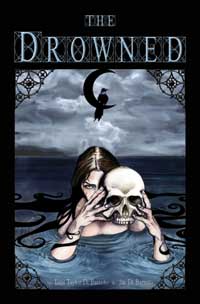
Hervé: So what is The Drowned about?
I would describe it as a tale of mystery and horror that set in the dark times after the French Revolution. The protagonist, Theophile Finistere, is introduced as a madman, but quickly is revealed to be much more than that. There are two separate supernatural revenge tales that intertwine. Because it is a story in which events are slowly revealed, to tell much of what "it's about" would potentially spoil the carefully orchestrated pacing of revelations in the book. Somewhat vaguely speaking, it's the story of Theo grappling with his sanity and trying to come to grips with the horrors of his past, all while working under the influence of unseen powers, to achieve unknown ends. Some eerie elements of the story involve witchcraft and a religious abomination of a particularly gruesome sort.
Hervé: What inspired you for this story?
Laini: The seed that ultimately grew into the story was a dream I had about a village on the shore, that was lost beneath the sea at high tide. By imagining, with Jim, who would live in such a place, the first few elements of the story were born. I'm very interested in the superstitions that ruled people's lives in past centuries, and in the suspicious imaginations that dreamed up witchcraft. The story really grew out of those interests.
Hervé: How much research did you have to do to create this period piece?
Laini: I spent some time at the library researching events at the turn of the 19th century, and pulled together previous reading I had done on witchcraft and the Knights Templar. Jim searched out visual reference for costumes and architecture.
Hervé: One thing that surprised me, considering the year the story is set and considering the country is that there is no mention of the French Revolution! Is that something you did by purpose?
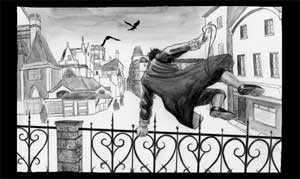
Laini: Actually, it's mentioned in the opening sequence of the story. I used a light touch in describing the historical setting because the story is much more driven by inner demons than by external events, and I didn't want to distract from Theophile's real journey. I chose to set the story in the year 1800 more as a moody backdrop than to actually involve the complex events of the period in the story.
Hervé: What other projects have you worked on?
Laini: I'm at work on a middle-reader series (for children ages 8 - 12) about faeries, but my previous published work is mostly illustration, not writing. I've done artwork for the children's magazine, Ladybug, and for a toy company, and mainly support myself selling my artwork.
Jim: I haven't worked on any sequential projects before, but I have contributed a number of illustrations to about ten White Wolf role playing game publications, including cover work. I have also done some CD cover artwork, design, and promotional art for a couple record companies and some editorial work here and there as well.
Hervé: What are your backgrounds and training?
Laini: I majored in English at UC Berkeley and became a travel book editor for Lonely Planet for a few years before deciding to go to art school at CCAC (California College of Arts & Crafts). I studied illustration for a year and half there before dropping out to continue my training on my own.
Jim: While my bachelor's degree is not art related, I've always loved to draw and was eventually inspired enough to enroll in art school after taking small community-organized art classes and night classes at a local Junior College. I then attended CCAC in San Francisco & Oakland where I studied Illustration and Drawing.
Hervé: You guys are relatively unknown in the comic book industry. What pushed you to create this graphic novel?
Jim: I first remember my mom getting comics for me when I was about 6 years old and sick. I was immediately hooked, and even though my interest has waxed and waned over the years here & there, I've now eventually become a bigger fan in the past few years more than I've ever been. That said, ever since I introduced Laini to certain comics to pique her interest, we've been interested in telling a tale of our own that's a bit out of the mainstream. Luckily for us, Image Comics provides creators with that opportunity and we couldn't be happier.
Hervé: Why did you choose to do a graphic novel instead of a mini-series?
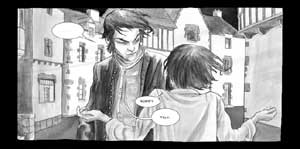
Jim: We love the idea of telling a story that is collected, contains a resolution, and has some shelf-life to it. While we enjoy monthly books, it's always a risk (especially for new creators) that you could begin a series, put out an issue, or two, or three, but then not be able to conclude your story due to lower-than-expected sales/orders. So, we simply wanted to make sure that our story got out as a whole, complete body of work.
Laini: As a voracious reader of fiction, I've never quite gotten used to the serial aspect of comics, especially the ones that seem never to come to a satisfying conclusion. As a writer, I'm more interested in telling self-contained stories. The narrative structure, then, can really be orchestrated more carefully, like a novel or a film.
Hervé: There has been several successful couples in American Comics, but you are one of the first to work together on a project as a writer artist team. How does this scenario plays out during the production?
Jim: It's been nothing but fun. Seriously. It was so much fun as an artist and a creative person, to have a hand in the development of the story because I was present at the inception of the plot. It just gave me such a feeling of having a true stake in the project, and when we landed the publishing deal, it added to the sense of accomplishment and excitement. Although whatever plot points or ideas I had, Laini took those and really ran with them and brought them, and her initial concepts, to the next level.
Laini: I left a lot more of the visual storytelling choices to Jim than a writer usually leaves to the artist. I really just gave him a script, with dialogue and extremely limited "stage direction", and he created the entire visual feel, including pacing, story-boarding and character design. But I was able to give input at every stage, while still leaving him a free hand. It worked great.
Hervé: Why did you guys choose the comic book format? This could have been a play or even a short movie?
A graphic novel was the point from the very beginning. Rather than having a story idea and wondering what to do with it, we started with wanting to do a graphic novel together, and coming up with a story just for that purpose.
Hervé: What attracts you to comic books?
Jim: I'm initially attracted to a comic based on its art (not necessarily the cover, as the art inside can vary drastically), but what will truly hold my attention is an intelligently written unique story, or a clever re-invention of something I'm familiar with. If the art is beautiful, but the story doesn't hold up (or vice versa), I may buy the book, but I probably won't be returning to it again and again.
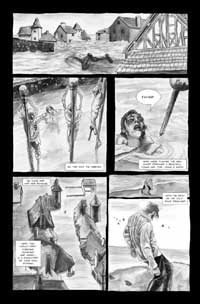
Laini: I'm attracted to the possibility of telling a dramatic story, and seeing another imagination at work bringing the visual component to my written work.
Hervé: Were you guys influenced by European comics. In tone and in style your work is decidedly European.
We're not too familiar with many European comics. We are fans of several European creators, but haven't really had the exposure to them to necessarily be very influenced by them. I really wish they were more readily available here in the states, but my wallet would definitely suffer as a result as many of them are album sized hard cover books.
Hervé: The artwork within the project is very dynamic. Yet you guys chose to render it as painted project. Painted projects tend to be more static. How can you pull this off for The Drowned?
Jim: I'm really pleased that you feel that way. I've been getting told that by a few other reviewers who saw advanced copies and I'm simply very pleased that folks acknowledge the dynamism I was intending. I guess the answer to "how" would maybe be that while I do shoot models for reference for my illustrations, I try to not get too constrained by the photos and always strive for fluidity instead of rigidity--does that make sense?
Laini: Also, Jim himself poses for many of the action shots in the book himself and is really good at getting the dynamic poses that he wants.
Hervé: How much effort does a painted project require versus line renderings?
Jim: Well, I know some artists that ink their own work who don't do a complete, highly detailed pencil drawing prior to inking, but then really focus in on tons of detail during inking. I also know painters who paint over quite loose drawings, adding in detail as they go. I, on the other hand do a tight drawing and then lay the paint in thereafter, basically sculpting light and shade with the paint. How much extra effort one takes over the other, I can't venture a guess--however, I will say this: it's ALL a heck of a lot of work!
Hervé: What technique are you using for The Drowned. It wasn¹t easy to guess, but it seems like water colours? (If it is water colour, it sure fits with the theme of the project!)
Heh. Most of the painting & texture is from watercolors, but there also was a fair amount of ink, gouache, acrylics, and digital manipulation used, as well as a product called Pen-Opake.
Hervé: I noticed that unlike many English-speaking writers who depict French speaking characters, or any other foreign language speaking hero, Laini did not continuously spice the captions and texts with French words. It there a reason for toning down the ³cultural² aspects?
Laini: There are many ways of handling this. I think that because the characters are ALL French, I was operating under the understanding that every word they spoke was in French. It seemed to me that to throw in a word or phrase here and there would only serve to jolt the reader OUT of the story, rather than pull him farther in. It would be like saying, "DON'T FORGET YOU'RE IN FRANCE!" I hope that the reader will feel the world of the story naturally and organically through the storytelling.
Hervé: Your story borrows a lot from 19th century Romantism. It¹s not a genre that¹s been tried very often in comics. How do you feel about trying specific literary genres in with comic books?
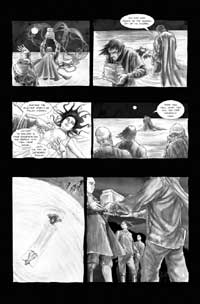
Laini: I didn't really analyze things like that. I just wrote a story that is the kind of story I like to read. As a reader, my favorite kinds of stories are those that are rich with details of worlds other than our own, be they fantastical, magical, or historical. Stories that transport you. I love the ornate richness of a good Gothic horror, I love to read different writers' takes on the supernatural, I love to find a window into a historical period I haven't previously explored.
Hervé: What are your expectations regarding your audience?
Laini: I hope readers will enjoy the carefully orchestrated story, the suspense and the resolution. In the past, I myself have been annoyed by a certain kind of avant-garde storytelling that is all about mood and mystery and completely drops the ball on satisfactory resolution, and I'm confident we've told a story that's gripping, suspenseful and also satisfying.
Hervé: Who is your target reader?
Ideally, I would say "everyone!," but I suppose our target audience is comic fans who enjoy a unique layered story that doesn't necessarily fit neatly into one specific genre. We also hope that fans of horror and supernatural fiction (i.e. novels) will be motivated to check out the graphic novel format and read our book.
Hervé: The usual college crowd and literary types will clamour your graphic novel for years and use it as an example for what can be achieved in what they like to call sequential arts. How can you bridge your work with comic book readers who aren¹t naturally attracted to such projects?
Wow, thank you so much! That's very kind of you! Hopefully word will spread to those who might not normally pick up a book like this, or they will be intrigued enough to be taken on a ride a little different from that which they are normally used to.
Hervé: How about regular book readers?
We heartily invite them to read it, and think they would not be disappointed. Hopefully word will spread through sources like yours and by word of mouth to those who are avid readers, but not necessarily readers of graphic novels.
Hervé: Why did you go with Image Comics for this project. Although very liberal, these last few years, they aren¹t who most people think about when it comes to Romantism and other literary genres?
We had met a few past and present creators who had talked so highly of their experience with Image Comics that they came to mind immediately. Ultimately, they were the only company we approached with the story at last years San Diego Comic Con and they (thankfully) agreed to allow us to work with them.
Hervé: How was the creative process? Was Laini strictly a writer and Jim the artists?
Laini: Jim helped greatly with the development of the plot while we were in the brainstorming stages. I wasn't really involved in the art process so much except as a sort of unofficial art director.
Hervé: How much time did it take you to prepare the publication of The Drowned?
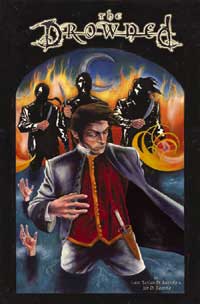
Jim: It really took the better part of 6 months to complete the book. While I had begun it a few months prior to that, I did some other illustration projects before focusing purely on THE DROWNED. The last 4 months or so required almost nothing but drawing, painting, lettering, and designing the book in the form of 15 -17 hour work days, 7 days a week. Sigh.
Hervé: Was the business part as easy as the creative parts?
The only real business part we had to deal with was the organization of the book dummies we printed up for distribution to reviewers as well as designing 3 postcards that got shipped out by Diamond to all the the countries' retailers to promote the book. Those things weren't really terribly time consuming, especially compared to the hundreds (thousands??) of hours involved in the creation of the book.
Hervé: What other types of projects would you like to work on?
We are NOT out of ideas for this storyline, and we are NOT out of ideas for other plotlines by a long shot (we have at least 2 other stories we're dying to tell in addition to a sequel to this story). So, we just really want to continue to tell what we think are unique tales with unlikely protagonists.
Hervé: Will The Drowned be distributed outside the direct market?
THE DROWNED will be distributed by Diamond throughout the country to comic book retailers, on Amazon.com, and through any and all bookstores. The Diamond order code is MAY04 1413 and the ISBN# is 1-58240-379-1.
Hervé: How much did you like the experience?
Jim: We've really loved it so far. In fact, I'm hoping to get started on something new in the near future (although I'll need to have a bit more time to work on a project of this size in order to be fair to Laini, our friends, and our dogs! 17 hour days just don't lead to a whole lot of social interaction).
Notes: The cover at the top of the article is the actual cover of the book. The one in the reviews and at the bottom of the article is the one used in the previews. I kept both for readers' enjoyment.
Last Updated: November 29, 2025 - 16:51






